Hold onto your leashes, because we’re diving into the wild world of paddywack dog chews! 🐾 What is a paddywack dog chew, you ask? It’s like a workout for their jaws – the Arnold Schwarzenegger of chews.💪
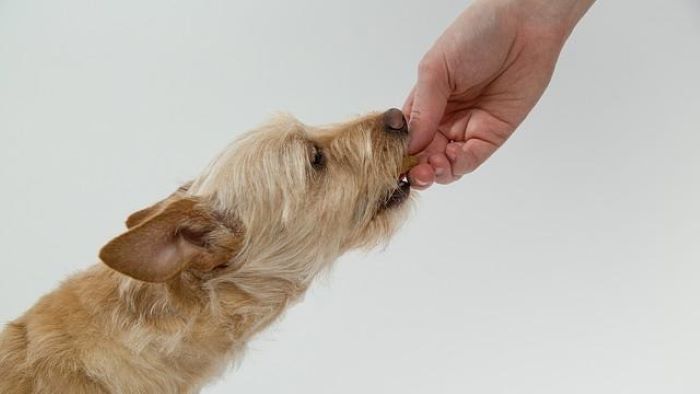
With more protein than a gym rat’s breakfast and less fat than a squirrel’s diet plan, paddywacks are the treat that’s got it all. It’s a special chew made from animal windpipes. So, get ready to explore the world of paddywacks and make your dog’s day a little more exciting and fun.🎉
What Is a Paddywack Dog Chew?
Initially a culinary curiosity for humans, paddywack was enjoyed in some cuisines. Over time, The chewy texture and savoury taste that once pleased human palates now captivate canine taste buds.
Paddywack is not your typical bone or biscuit; rather, it’s a chewy delight crafted from the windpipes of cattle or sheep. Chewing is more than just a pastime for dogs; it’s an essential behaviour that promotes dental health, relieves stress, and maintains strong jaw muscles[1]. 🦴
Paddywack chews serve as both a delicious treat and a chewing workout. Dogs savour the rich taste and texture, and these chews satisfy their innate chewing instincts while providing entertainment and a tasty hobby.🐶
Benefits of Paddywack Dog Chews
Incorporating paddywack dog chews into your pet’s routine addresses multiple facets of their health – from their teeth and gums to their mental engagement and physical strength. Paddywack chews provide many benefits that make them one of the best dog chews available. Here are some more benefits of giving your dog paddywack dog chews:
1. Dental Health
Paddywack dog chews offer more than just a flavorful experience – they play a vital role in maintaining your furry friend’s dental health. As dogs chew on these treats, their gnawing action helps scrape away plaque and tartar buildup from their teeth. 🦷
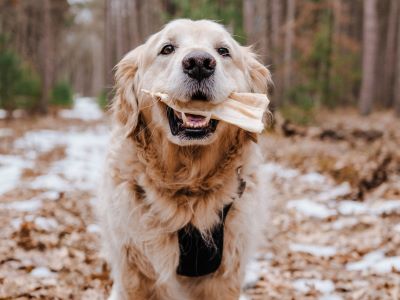
By reducing these potentially harmful deposits, paddywacks contribute to healthier gums and fresher breath. This proactive dental care can prevent issues like gum disease, tooth decay, and bad breath, promoting a sparkling smile!😁
2. Mental Stimulation
Beyond the joy of indulging in a tasty treat, paddywack chews provide an engaging mental workout for your pup. Dogs are natural chewers, and the act of gnawing on a chewy treat like a paddywack keeps their minds occupied and alert.🐕
“Mental stimulation is essential for a happy and well-balanced pup, and paddywacks offer an enjoyable way to provide it. It alleviates boredom and restlessness, channelling their energy into an activity that stimulates their senses and keeps them entertained”, says the experts at WebMD.
3. Natural Ingredients
One of the standout features of paddywack dog chews is their reliance on natural ingredients. Derived from the windpipes of cattle or sheep, these treats are free from artificial additives and preservatives.🐮
This natural approach ensures that your dog enjoys a wholesome snack that aligns with their dietary needs. Offering treats with recognizable ingredients fosters trust in the products you give your pet and reflects a commitment to their well-being.
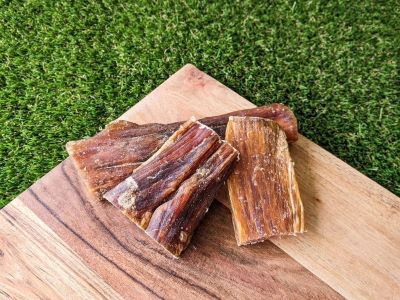
4. Exercise for Jaw Muscles
A strong set of jaw muscles is crucial for a dog’s overall health and well-being. Chewing on paddywack chews serves as an effective exercise routine for these muscles. The repetitive motion of chewing helps strengthen jaw muscles over time, promoting better oral health and facilitating proper bite alignment. 🦴
This exercise is particularly beneficial for dogs of all ages, from puppies cutting their first teeth to older dogs maintaining their jaw strength.
Also, as your dog delights in the tasty satisfaction of a paddywack, you can take comfort in knowing that you’re providing them with a treat that supports their well-rounded wellness!🩺
How Paddywack Chews Are Made?
Let’s find out how paddywack chews are made and end up as our dog’s favourite treats at our homes:
Sourcing Paddywack
The journey of a paddywack dog chew begins with sourcing high-quality tracheas from cattle or sheep. These tracheas are carefully selected to ensure they meet safety and quality standards.
Responsible suppliers prioritize the welfare of animals, choosing sources that stick to honest practices and maintain good hygiene. This ensures that the paddywack chews are derived from healthy animals, setting the foundation for a safe and nutritious treat.🍖
Cleaning and Preparation
Once sourced, the tracheas undergo a thorough cleaning process. This involves removing any residual tissues and debris to create a clean canvas for the chews.🧼

Cleaning is a critical step to guarantee the safety and hygiene of the final product. Careful handling during this stage ensures that the paddywacks are free from contaminants and safe for consumption by dogs.
Cooking and Drying Process
The cleaned tracheas then enter the cooking and drying phase. Cooking helps eliminate harmful pathogens, making the chews safe for dogs. Depending on the manufacturer’s approach, some paddywacks might also be smoked during this process to enhance flavour and aroma.🍳
Drying is essential to reduce moisture content, preventing spoilage and ensuring a longer shelf life. This meticulous process preserves the chewy texture while locking in the delectable taste.
Packaging and Distribution
After cooking and drying, the paddywacks are carefully inspected for quality and consistency. Once approved, they are packaged in secure, airtight containers to maintain freshness and prevent contamination.📦
Labels often provide information about ingredients, nutritional content, and usage guidelines, helping pet owners make informed choices. The packaged paddywack chews are then distributed to pet stores, online retailers, and other outlets where dog lovers can easily access them.
Throughout these stages, maintaining strict quality control measures is essential. Manufacturers often stick to industry regulations and certifications to ensure the safety and integrity of the product.
Transparent communication about sourcing, processing, and quality assurance fosters trust between manufacturers and consumers, reassuring pet owners that they are offering their furry friends a treat they can enjoy with confidence.
In essence, the journey from sourcing paddywack to distributing it as a dog chew involves careful steps to deliver a safe, nutritious, and delightful treat that dogs love.💌
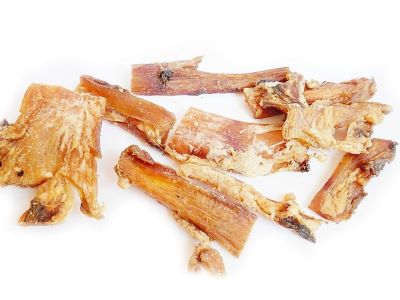
Incorporating Paddywack Chews into a Dog’s Routine
Here are some important things to take into consideration so you can make the paddywack chews a safe and enjoyable addition to your dog’s diet:
1. Suitable Dog Breeds and Sizes
Paddywack chews can bring joy to a variety of dog breeds and sizes. They are particularly well-suited for medium to large breeds due to their durable nature. Dogs like Labradors, Golden Retrievers, and Bulldogs can happily indulge in the satisfying chewing experience these treats offer.
Smaller breeds might also enjoy paddywacks, but it’s important to choose an appropriately sized chew to ensure safety and comfort.🐩
2. Frequency of Chewing Sessions
The frequency of chewing sessions depends on your dog’s individual needs and preferences. Some dogs might enjoy daily chewing, while others might be content with a few times a week.⌚
Observing your dog’s behaviour and listening to their cues can help you determine how often to offer paddywacks. It’s essential to strike a balance – enough to provide dental and mental benefits, but not excessive to avoid overconsumption.
3. Monitoring while Chewing
It’s always a good idea to keep an eye on your furry friends while they enjoy their paddywack chew. Monitoring👀 ensures they are chewing safely and not trying to swallow large pieces. 🍖
Occasionally, a larger piece might break off, and you want to be there to prevent any potential choking hazards. Supervising your dog’s chewing sessions is a responsible way to make sure they’re getting the most out of their treat.
4. Allergies and Sensitivities
Just like humans, dogs can have allergies or sensitivities to certain foods. Before introducing paddywack chews or any new treat, it’s wise to check for any ingredient sensitivities your dog might have.

If you’re unsure, consult your vet. Choosing single-ingredient chews like paddywacks can be a good choice, as they typically contain fewer potential allergens.🤧
5. Balancing with a Regular Diet
Paddywack chews are a delightful addition to your dog’s routine, but they should complement their regular diet rather than replace it. These chews offer mental stimulation and dental benefits, but they aren’t complete meals. 🍲
Ensure your dog’s main diet consists of nutritionally balanced dog food that meets their dietary requirements. Think of paddywacks as the dessert of the dog world – a delightful treat to be savoured alongside their regular meals.🍴
Offering paddywack chews on a regular basis provides positive reinforcement. It gives your dog an acceptable chew toy to stop dog chewing skirting board and furniture.
Paddywack Chews vs. Other Dog Chews
Always consider your dog’s size, chewing habits, and any potential allergies when selecting treats, and remember to supervise your dog while it enjoys its chews to ensure its safety. Here are some ways to help you choose the right chew for your dog’s preferences and needs:
Rawhide Chews
Rawhide chews are popular treats made from the inner layer of cow or horse hides. They’re treated and processed to become chewable for dogs. These chews are durable and can provide long-lasting entertainment. 🦴
However, it’s important to choose high-quality rawhide and supervise your dog while they chew, as larger pieces can pose a choking hazard or cause digestive issues if swallowed. Rawhide chews can be a satisfying way for dogs to exercise their jaws and keep their teeth cleaner.
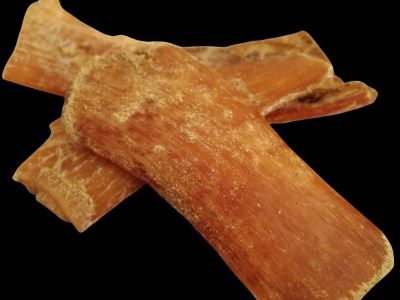
Bully Sticks
Bully sticks, also known as pizzle sticks, are made from the dried muscle tissue of bull or steer penises. They’re highly digestible and a great source of protein. Bully sticks are less processed compared to some other chews, making them a more natural option. 🍖
They come in various sizes and shapes, catering to different dog sizes and chewing preferences. While they provide dental benefits and mental stimulation, they can be calorie-dense, so portion control is essential to avoid excessive calorie intake.
Dental Chews
Dental chews are specially designed to promote oral health. But how many dental chews can a dog have a day? They often have ridges, textures, or ingredients that help scrape away plaque and tartar as dogs chew. Dental chews can come in various forms, such as bones, sticks, or rings.
These chews can be a convenient way to support your dog’s dental hygiene while providing an enjoyable chewing experience. However, they’re not a substitute for regular tooth brushing, especially for dogs prone to dental issues.🦷
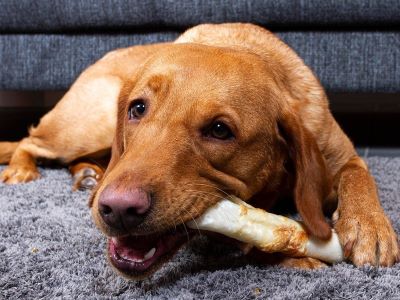
Edible Bones
Edible bones, often made from ingredients like rice, starch, and other natural components, offer a chewable treat that dogs can consume entirely. They come in various shapes and sizes and are designed to be easily digested. Edible bones can be a safer alternative to traditional bones, which can splinter and cause harm. 🦴
These treats can satisfy your dog’s urge to chew while providing a flavorful snack. It’s essential to choose edible bones that match your dog’s size and chewing habits to ensure safe consumption.
FAQs
What Is a Paddywack Dog Chew?
Paddywacks are made from the ligaments of sheep or cows. The ligament is quite difficult to digest, so its nutritional value is low, but they are often low in fat and may be lower in calories than other chews. Paddywacks may help to reduce plaque or tartar, but there is a risk of fracturing teeth if they are too hard.
Are Paddywack Dog Chews Good for Dogs?
Their toughness and ridged texture mean that chewing a Paddywack will have an abrasive action on dogs’ teeth, and this may help to reduce the levels of tartar and plaque that accumulate on their teeth. It may also make their breath smell a little fresher!
Which Dog Chews to Avoid?
Among other things, give no animal bones, no antlers, no hooves and no hard plastic or hard nylon bones. If an object is harder than a tooth, or if you could drive a nail with it, it’s too hard.
Can a Puppy Have Paddywack?
Not suitable for puppies under 4 months old. Remove when appropriate to prevent hazards. Composition: Dried Beef Paddywack (100%).
What Is the Safest Thing for Dogs to Chew On?
Bully Sticks. Considered probably the safest of the edible chews, we do know of one dog who died due to an intestinal blockage from a bully stick. Antlers. Hooves. Rawhides. Baked or Cooked Bones. Stuffed Chews: Kongs. Benebones, and Raw Bones.
Conclusion
To sum up, the question What is a paddywack dog chew? then it is an all-in-one treat for your furry friend. Besides long-lasting chewing sessions, there are many oral and nutritional benefits to it. 🐶
It’s important to pick the right size for your dog, watch them while they chew, and be careful if they have allergies. Remember as responsible pet parents it is our duty to provide the right food and fun to our loyal companions! 🐾
Reference:
- Destructive chewing. (n.d.)- ASPCA.



